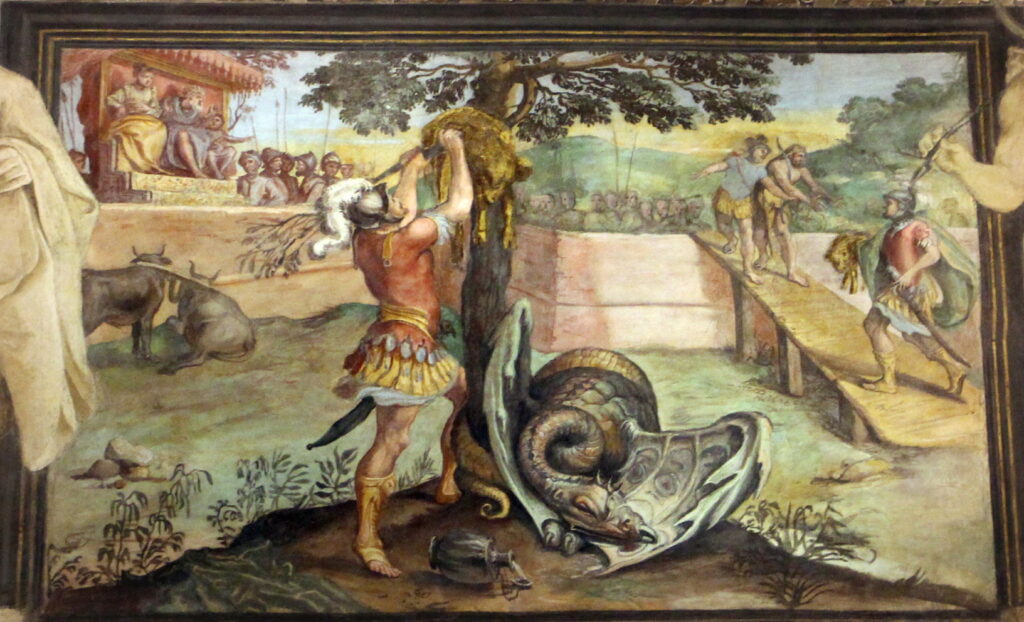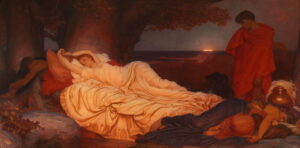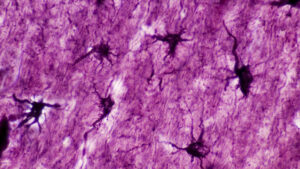Changing Paintings: 30 Jason, Medea and the Golden Fleece

Ovid starts the seventh book of his Metamorphoses with myths concerning Jason, Medea, and the Golden Fleece. Although these take up the first half of this book, he only summarises long and complex stories told more fully elsewhere. They also present a problem in consistency of theme. For the Metamorphoses to provide reasonably comprehensive coverage of all the major contemporary myths, they’re essential, but lack the transformations promised by the title.
The book drops us into the story of Jason and the Golden Fleece just as Jason has learned of the three tasks he must complete to obtain the prize. Medea, the daughter of King Aeëtes of Colchis, considers that her father’s demands are too harsh, and is torn between desire and reason. She recognises that she has fallen in love with Jason, and is already considering wild thoughts of marriage to him.
She thus resolves to provide him with every aid that she can to assist his mission, in the hope that this will ensure their marriage and secure her future glory. Medea therefore goes to an old shrine to Hecate, where she meets Jason and teaches him how to use magic herbs to accomplish the tasks.
John William Waterhouse (1849–1917), Jason and Medea (1907), oil on canvas, 131.4 x 105.4 cm, Private collection. Wikimedia Commons.
Several artists, notably those of the late nineteenth and early twentieth centuries, have explored Medea’s role, and her relationship with Jason at this stage of the story. In John William Waterhouse’s Jason and Medea (1907), she’s depicted as a sorceress, preparing the potions Jason was about to use to accomplish his tasks. He appears anxious, ready to go and tackle his challenge.
Frederick Sandys (1829–1904), Medea (1866-68), oil on wood panel with gilded background, 61.2 x 45.6 cm, Birmingham Museum and Art Gallery, Birmingham England. Wikimedia Commons.
Frederick Sandys shows Medea (1866-68) at work, preparing a magic potion for one of Jason’s missions. In front of her is a toad, and other ingredients. Behind her, in a gilt frieze, is Jason’s ship the Argo.
The following day, watched by the king, Jason succeeds in his first task of yoking a team of fire-breathing bulls, and using them to plough a field which had never been ploughed before, enabled by a herbal ointment provided by Medea.
As he is ploughing, Jason sows the teeth of a dragon, required for his second task. As with those sown by Cadmus before he founded the city of Thebes, those teeth instantly grow into an army who point their spears at Jason. Medea tells him to throw a large rock into their midst, to draw their attention so they kill one another instead of Jason.
Jason moves on to his final task, to provide him with the Golden Fleece, but first has to get past the dragon guarding it. He sprinkles another of Medea’s herbal preparations on the guardian and recites a magic spell three times to put the dragon to sleep.
Annibale Carracci (1560–1609) (and Agostino, Ludovico Carracci), Jason and Medea (one painting from 18) (c 1583-84), fresco, dimensions not known, Palazzo Ghisilardi Fava, Bologna, Italy. Image by Sailko, via Wikimedia Commons.
The frescoes of the Palazzo Ghisilardi Fava in Bologna give a superb account through eighteen separate images. Although directed by Annibale Carracci, it’s thought that his brother Agostino and cousin Ludovico also made significant contributions during the painting between about 1583-84.
This uses elaborate multiplex narrative to summarise much of Ovid’s account: at the left, two of the fire-breathing bulls are still yoked, in front of King Aeëtes. The army sprung up from the dragon’s teeth appear behind the wall, armed still with spears but no longer fighting. In the foreground, Jason has put the dragon to sleep using Medea’s magic concoction, and is unhitching the Golden Fleece while he can. At the right, two of the Argonauts offer to help Jason (shown a second time) carry the fleece away.
Jean François de Troy (1679–1752), The Capture of the Golden Fleece (1742), oil on canvas, 55.6 x 81 cm, The National Gallery, London. Wikimedia Commons.
In Jean François de Troy’s The Capture of the Golden Fleece from 1742, Jason reaches up to take the Golden Fleece from a branch of an oak tree. The artist has interpreted this prize as a lamb of rather modest size. However, the hero’s left foot rests on the body of the dragon, whose nostrils emit steam. To the left of Jason is Medea, dressed as an eastern princess, and surrounding them are the Argonauts, whose ship is seen at the far left, preparing to set sail.
Gustave Moreau (1826–1898), Jason (1865), oil on canvas, 204 × 115 cm, Musée d’Orsay, Paris. Wikimedia Commons.
Gustave Moreau’s Jason (1865) oddly excludes Medea from its title. She stands almost naked behind Jason, holding a vial in her right hand, and her body is swathed with the poisonous hellebore plant, a standard tool of witchcraft. It has been suggested that these allude to Jason’s later rejection of Medea and her poisoning of Glauce, but that’s not borne out by the only clues provided by Moreau in the almost illegible inscriptions on the two phylacteries wound around the column.
Cooke has deciphered their Latin as reading:
nempe tenens quod amo gremioque in Iasonis haerens
per freta longa ferar; nihil illum amplexa timebo
(Nay, holding that which I love, and resting in Jason’s arms, I shall travel over the long reaches of the sea; in his safe embrace I will fear nothing)
et auro heros Aesonius potitur spolioque superbus
muneris auctorem secum spolia altera portans
(And the heroic son of Aeson [i.e. Jason] gained the Golden Fleece. Proud of this spoil and bearing with him the giver of his prize, another spoil)
These imply we should read the painting in terms of the conflict between Jason and Medea: Medea expresses her subjugate trust in him, while Jason considers her to be just another spoil won alongside the Golden Fleece. When exhibited at the Salon in 1865, the critics were unsure of what they were supposed to be looking at, and Moreau’s narrative was irretrievable amid his surfeit of symbols.
Erasmus Quellinus II (1607–1678), Jason and the Golden Fleece (1630), oil on canvas, 181 × 195 cm, Museo Nacional del Prado, Madrid. Wikimedia Commons.
This is the sort of narrative you might have expect Rubens to have painted, and he did prepare some sketches of the motif. It was his pupil and collaborator Erasmus Quellinus the Younger (1607–1678), though, who produced this finished painting of Jason and the Golden Fleece in 1630, probably within Rubens’ workshop.
Once the dragon is slumbering deeply, Jason seizes the Golden Fleece, and sails with Medea and his prize to his home port of Iolcus.
Herbert James Draper (1863–1920), The Golden Fleece (1904), oil on canvas, 155 x 272.5 cm, Bradford Museums, Bradford, England. Wikimedia Commons.
Herbert James Draper shows one account of the tactics employed in The Golden Fleece from 1904: as Jason and his Argonauts are sailing away, Medea throws her brother into the sea, forcing her father to stop to recover him, so allowing the Argo to escape from the pursuit.


